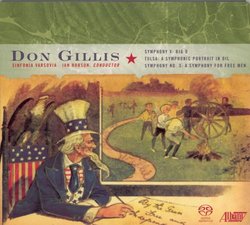Quintessentially American Orchestral Music from the Mid-20th
J Scott Morrison | Middlebury VT, USA | 09/01/2007
(5 out of 5 stars)
"From the excellent booklet notes by Ray Bono: 'Some artists -- titanic creative geniuses -- drag us along with them on their storm-buffeted struggles ... There are other artists, less than titans, [who invite us in] and say 'You there -- come on over! Take a load off! Get in out of the rain!' Engaging conversationalists, they may crack a joke, share an intimacy or hazard a word of advice, talking simply in our own language...And in their company we can relax and feel nicely refreshed.' Don Gillis was of the latter sort. He was not a great composer, but he was a talented musical craftsman, a brilliant orchestrator and writer of memorable tunes, all the while speaking in the musical vernacular of the middle of the 20th Century in America. And his music was one of my first discoveries as a very young concert-goer that Americans could write symphonic music, too. Consequently I have a very warm place in my heart for his works. Ian Hobson -- an Englishman! -- and the Sinfonia Varsovia -- Poles! -- have been recording all of his symphonies and other orchestral works and the series has been simply delightful. This latest issue is no exception. It includes two of his symphonies, one early and one late, and one of his cityscape tone poems, this one about a city I knew very well as a boy, Tulsa.
Gillis's musical language is laced with optimism, patriotism, pleasure in simple things, and a wicked sense of humor. 'Symphony X: Big D' (1968) is a portrait of Dallas in four movements: All-American City, Requiem for a Hero, Conventioneer, and Cotton Bowl. The hero in II is, of course, John F. Kennedy whose tragic assassination was in Dallas. I is a broad-shouldered paean to Dallas, III a tipsy celebration of all those conventioneers who came to Big D for a good time, and IV is full of the rah-rah spirit of the city's football stadium. The music itself is open-faced, melodic and unabashedly American.
'Tulsa: A Symphonic Portrait in Oil' (1950) is a ten-minute tribute to 'The Oil Capital of the World', as the city termed itself. It was commissioned by Tulsa's largest bank in the aftermath of Gillis's success with his humorous Symphony No. 5 1/2. Oklahoma's 1889 land rush during which Tulsa was founded is pictured as are a square dance and the capping of an oil well. The orchestration calls for the firing of a real six-shooter in the land grab section.
The three-movement 'Symphony No. 3' is one of Gillis's wartime works. Written in 1942 it is subtitled 'A Symphony for Free Men'. Naïve as this may sound now, the work's fervently patriotic tone captures the temper of the times. It was premiered by Howard Hanson, a supporter of Gillis's work, and the Eastman-Rochester Symphony in 1945; its earlier premiere had been delayed by the exigencies of the War. Gillis apparently was later a bit embarrassed by the work and he discarded the full orchestral score. Conductor Ian Hobson reconstructed the work from orchestral parts. The symphony is more serious than many of Gillis's works and is laced with brass fanfares, brawny chorales based on American-sounding melodies, passages of plaintive self-reflection and undying fervency that somehow evoke faith in America and its ideals.
This is yet another in the series of marvelous performances resurrecting this minor but valuable composer's work. For someone like me who was imprinted on his music, it adds to my knowledge and enjoyment of his work. The performances and sound recording are all one could ask for.
Scott Morrison"
Best Recording of "Tulsa," Hands Down
Neil Cotiaux | North Canton, Ohio United States | 12/05/2009
(5 out of 5 stars)
"5 Stars based exclusively on "Tulsa."
For those Gillis aficionados who have followed this composer's discography, the coupling of "Tulsa" and "Symphony X" poses a bit of a problem: Symphony X is featured on the Albany Symphony's excellent sampling of Gillis works that features an absolutely first-rate reading of his career-defining "Symphony 5 1/2." So, what to do: buy this CD or purchase Albany?
The answer may lie with how fervently the listener enjoys Gillis' bracing tone poem to the self-annointed Oil Capital of the World. Having heard four recordings of "Tulsa" including this one, the Hobson/Varsovia treatment is by far the most professional - full symphonic gravitas, a pell-mell land grab, a somewhat chilling cyclonic escalation of the gusher and excellent use of the fiddles in the hoe-down finale (the only section that seems a bit rushed by Hobson, more in line with the earliest European recording of the piece, which had struck me as awfully brisk). The score here is the composer's, not the often-played arrangement by Maurice Ford, but the percussive coloration is equally pronounced. And - big plus - the woodwinds are consistently up to the challenge that Gillis threw down in the last third of this delightful work (North Texas State and a Swiss marching band exposing how difficult those high notes can be).
One cautionary note: This is an SACD recording. My first encounter with this disc was disappointing. It was only when I played it on higher-end technology that the full subtleties of the score could be discerned.
Bottom line: If you are a true fan of "Tulsa," this is the best reading of the piece you'll find."


 Track Listings (3) - Disc #1
Track Listings (3) - Disc #1